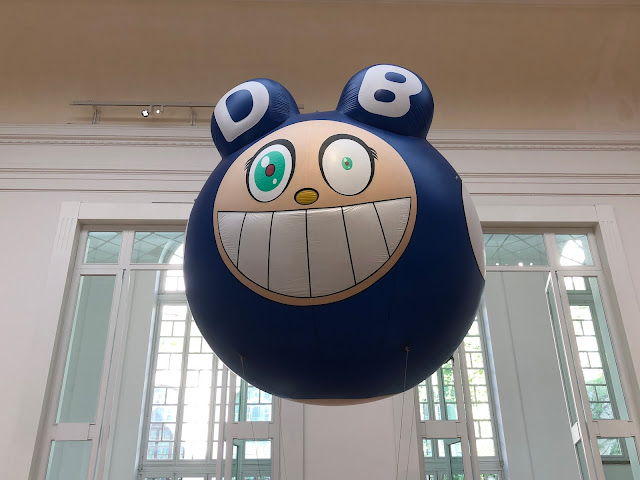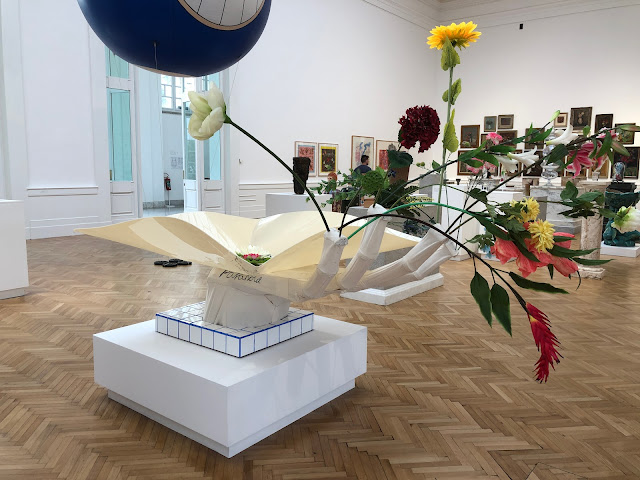【ローマ】国立近代美術館 1930年日本美術展 Roma - National Gallery of Modern and Contemporary Art & 1930 Japanese Art Exhibition
ローマの国立近代美術館を訪れた際に、花をテーマにした企画展が開催されていた。
美術館のエントランスを入ってすぐの部屋に展示されていて、規模は小規模だったが、花がテーマというだけあって、カラフルな展示が多く、それなりに楽しめた。
日本からは、村上隆や岩元航大などの作品が展示されていた。
When I visited the National Museum of Modern Art in Rome, a special exhibition on the theme of flowers was held.
It was exhibited in the room right after the entrance of the museum, and although it was small in scale, there were many colorful exhibits because the theme was flowers, and I enjoyed it as it was.
From Japan, works by Takashi Murakami and Kodai Iwamoto were exhibited.
この美術館では、1930年に日本美術をテーマにした展覧会が行われた、という話を以前耳にしたことがあり、とても興味を引かれた。
その展覧会を企画したのは、ホテルオークラを創業した大倉喜八郎だった。大倉は事業活動の傍で、文化芸術にも造形が深く多くのコレクションを持っていた。
さらに、大倉集古館という美術館を作り、そうしたコレクションを一般にも公開していた。
大倉は、1925年からイタリアで独裁体制を布いていたムッソリーニが日本の文化に強く興味を持っていることを知り、イタリア政府にローマでの日本美術展を提案したという。
I had heard before that an exhibition on the theme of Japanese art was held at this museum in 1930, which was very interesting.
The exhibition was planned by Kihachiro Okura, the founder of Hotel Okura. Aside from his business activities, Okura was deeply modeled in cultural arts and had many collections.
In addition, he created an art museum called Okura Museum of Art, which was open to the public.
Okura learned that Mussolini, who had been dictatorship in Italy since 1925, had a strong interest in Japanese culture, and proposed to the Italian government an exhibition of Japanese art in Rome.
この展覧会には日本政府は全く関係しなかったようだ。
展覧会の開会式には、イタリア側からはムッソリーニ首相を始め政府の高官たちも出席したが、日本からは大倉や作品を制作した画家などの民間人のみだった。
その開会式の写真を見たことがあるが、横山大観が一人だけ和服を着ている姿がとても印象的だった。
It seems that the Japanese government had nothing to do with this exhibition.
The opening ceremony of the exhibition was attended by Prime Minister Mussolini and other high-ranking government officials from the Italian side, but from Japan only civilians such as Okura and the painter who produced the work.
I have seen the photo of the opening ceremony, and it was very impressive to see Taikan Yokoyama wearing only one kimono.
その時に展示された作品は80人の画家たちによる160点以上の作品だったという。
当時の日本の画壇は、日本の政府の支援を受けている官展派と、それに反発した岡倉天心らが始めた院展派の二つに分かれて対立していた。
大倉は、この展覧会では日本の最高の作品を展示する必要があることを両者に説いて、両派から当時の主要な画家たちが参加した。
院展派からは横山大観、菱田春草、下村観山らが、そして官展派からは竹内栖鳳、川合玉堂らが作品を出展した。
そのうちの何点かは、大倉集古館に今も収蔵されている。
It is said that the works exhibited at that time were more than 160 works by 80 painters.
At that time, Japanese painters were divided into two groups, the government exhibition group, which was supported by the Japanese government, and the institute exhibition group, which was started by Tenshin Okakura and others who opposed it.
Okura explained to both parties that it was necessary to exhibit the best works of Japan in this exhibition, and major painters of the time from both groups participated.
Works by Taikan Yokoyama, Hishida Shunsou, Kanzan Shimomura, etc. from the institute exhibition group, and Takeuchi Seiho, Kawai Gyokudo, etc. from the government exhibition group exhibited.
Some of them are still stored in the Okura Museum of Art.
この展覧会は好評を博し、イタリアのみならず他のヨーロッパの国々からも人々が訪れて、連日2,000から3,000人が訪れたという。
この展覧会のおかげということではないだろうが、その後、イタリアと日本は関係を深めていくこととなった。
1931年には満州事変が起こり、日本は中国への進出をますます進め、アメリカやイギリスなどの国との対立を深めていった。
一方のイタリアは、ナチスのドイツとの関係を深めていき、やがて利害が一致した3カ国は、1937年に日独伊防共協定を、1940年には日独伊三国同盟を締結した。
The exhibition was well received and attracted 2,000 to 3,000 people every day, not only from Italy but also from other European countries.
It may not be because of this exhibition, but after that, Italy and Japan deepened their relationship.
The Manchurian Incident occurred in 1931, and Japan continued to expand into China, deepening conflicts with countries such as the United States and Great Britain.
Italy, on the other hand, deepened its relations with Germany in the Nazis, and the three countries with the same interests eventually signed the Japan-Germany-Italy Anti-Comintern Pact in 1937 and the Tripartite Pact of Japan, Germany and Italy in 1940.







コメント
コメントを投稿